Cybersecurity company SAM Seamless Network wants to fight cyber threats at the source by securing network gateways. And they want it to be easy for the users, whether it is for the home of their office building. SAM won the ‘best broadband partnership for connected services’ at the Broadband World Forum in Amsterdam last October. Their advisory board includes Intel, ADT, Blumberg, Nightdragon, and Team8. In light of the company’s recent win, we spoke to Chief Revenue Officer Pirjo Tuomi at the Amsterdam event.
DirectIndustry e-magazine: Tell us about the cybersecurity software that SAM Seamless Network offers.
Pirjo Tuomi: The software by SAM is a gateway-based security solution that is 5G ready. We can integrate our software to nearly any gateway, even six-year-old gateways. From the gateway, we protect the entire home. There are three components: the SW Agent, a mobile app and a cloud and analytics dashboard. The SW Agent detects and connects to the devices accessing the network, protecting the router in the household or building from unauthorized use. The data is stored in the back office in the cloud, using AI to provide preventative monitoring. The agent categorizes the types of devices, putting them into specific zones. Since IoT devices currently create a high-risk cyber threat, we put them in one zone. Guests are in one zone as well. The devices cannot communicate with devices from a different zone. The data analytics identify when a device is doing something it’s not supposed to, i.e. a camera might be accessing a different zone when it’s not technically allowed. This signals a problem.
DirectIndustry e-magazine: Who’s responsible for contacting the homeowners about the potential cyber threat?
Pirjo Tuomi: The homeowner has access to the dashboard and is essentially responsible for looking into the situation, but we can also allow the provider to access the dashboard in order to have visibility and potentially act as security manager. There are two options: a provider can receive reports and alerts when active malware occurs or the customer can get the phone app and receive the reports. There are many alerts that occur throughout the day, so we don’t recommend choosing to have all of the alerts sent but rather a report on how many attacks took place and alert when there are the serious attacks. The AI-based software gives the end user recommendations, but providers can offer packages that include assistance from their IT team; this is a good option for businesses like small shops, accountants, doctors, lawyers. For these types of businesses with sensitive data but no in-house IT team, the provider can offer monitoring. Millions of routers are already being sold with our software.
DirectIndustry e-magazine: Do you think it will be easier for customers if network operators take the lead in setting this up for them?
Pirjo Tuomi: Yes, because the customer will simply need to download the software. Zone creation is done automatically since the software can detect the nature of the devices. As soon as you turn on a device the software picks it up instantly and plugs it into one of the appropriate zones. It only takes 5 to 10 minutes.
DirectIndustry e-magazine: We’re wondering who’s paying for the development of 5G tech at the end of the day. A lot of speakers have talked about monetizing. Some have said that offering high cybersecurity will be a money-making deal. What do you think?
Pirjo Tuomi: Absolutely. It adds to the services they can provide. The growing number of IoT devices means we need to manage security solutions, and operators need to find a way to provide this service. At some point the regulatory system will change, too—bank security, for example—and operators might soon be required to provide security. Operators who choose to incorporate a security solution for their clients not only gain consumer knowledge but see a revenue increase. Those who have already started offering integrated cybersecurity software have seen an 11% revenue increase. The churn decrease for SAM subscribers is high.












